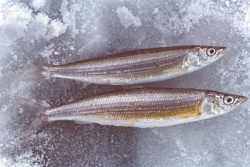
The more colorful male is on the bottom.
Size of samples not indicative of gender.
Click to view a larger image.
Photo Courtesy &
Copyright © 1979, 2009 Ron Goede
In mid-January you can witness frenetic fishing along the south-eastern shore of Bear Lake. The Bonneville Cisco are spawning.
These small whitefish are numerically the most abundant fish species in Utah, even though, Cisco are endemic to Bear Lake. And although attempts have been made to transplant them to other waters, they continue to thrive only in Bear Lake.
There are in fact, more endemic fish in Bear Lake than in any other north-American lake: the Bonneville Cisco, the Bear Lake Whitefish, the Bonneville Whitefish and the Bear Lake Sculpin. These deep water salmoniform fish also inhabited Pleistocene Lake Bonneville, the great freshwater sea that covered vast portions of Utah and surrounding states.
The Bonneville Cisco is differentiated from other whitefish by its pointed mouth and smaller size. Growing no larger than 9 inches, it is pale moss green on top with silver sides. Cisco don’t have the spots found on other whitefish.
Cisco eat only small aquatic invertebrates or zooplankton. They are eaten by larger fish in the lake including cutthroat, lake trout, and whitefish. When caught, they are most often breaded whole and deep-fat fried or smoked. Sometimes they are frozen and used as bait to catch cutthroat and lake trout later in the year.
Cisco mature at 3 years and, for a two-week period, prefer spawning on the south-eastern, rocky beach known appropriately as Cisco Beach. The males move first to the area where they wait for the females to arrive. Low water levels in the lake sometimes keep Cisco from the beach; but using fish finders, anglers have found that Cisco spawn in other places throughout the lake. However, they still prefer rocky locations, even if they are in deeper water.
Schools swim parallel, but 3-8 feet from the shore. During ice-on conditions, fishermen drill up to 18-inch holes and fish with nets or lines through the holes. With ice-off, they wade into the water, using smelt nets. Out in the lake, Cisco are caught with lures such as spoons and jigs instead of nets. The current limit is 30.
So if you are near Bear Lake in mid-January, dress warmly and enjoy this unique fishing phenomenon found nowhere else in the world.
Credits:
Picture: Courtesy & Copyright © 1979, 2009 Ron Goede, https://www.bridgerlandaudubon.org
Voice: Linda Kervin, Bridgerland Audubon Society https://www.bridgerlandaudubon.org
Text: Lyle Bingham and Ron Goede, Bridgerland Audubon Society https://www.bridgerlandaudubon.org
Additional Reading:
Fishes of Utah: A Natural History (Hardcover)
by William F. Sigler (Author), John W. Sigler (Author), Joseph R. Tomelleri (Illustrator),
https://www.amazon.ca/Fishes-Utah-William-F-Sigler/dp/0874804698, pp 23, 24, 194-196
Are Bear Lake’s Ciscos a Joy or Curse?, Angler Guide, https://www.anglerguide.com/articles/112.html
Fishing, Bear Lake Valley Convention & Visitors Bureau, https://bearlake.org/fishing/
Prosopium gemmifer, Bonneville cisco, FishBase, https://www.fishbase.org/Summary/SpeciesSummary.php?id=2683
Utah’s Wildlife Action Plan, Utah Division of Wildlife Resources, Utah Division of Natural Resources, State of Utah, 2015-2025, https://wildlife.utah.gov/discover/wildlife-action-plan.html
Winter Fishing Comes Naturally at Bear Lake, Utah Outdoors, https://www.utahoutdoors.com/pages/bear_lake_winter.htm
Bonneville Cisco Prosopium gemmifer, Fieldguide, Utah Division of Wildlife Resources, Utah Department of Natural Resources, https://fieldguide.wildlife.utah.gov/?species=prosopium%20gemmifer
Bonneville Cisco Prosopium gemmifer, Species Status Statement, [Version 2020-04-20], Utah Division of Wildlife Resources, Utah Department of Natural Resources, https://wildlife.utah.gov/pdf/sensitive_species/fishes_bonneville_cisco_2020.pdf
